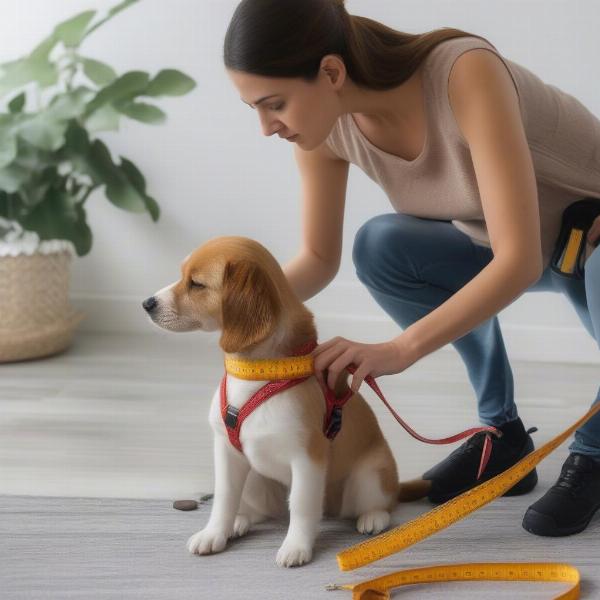A balance harness, sometimes called a lifting harness or support harness, can be a game-changer for dogs struggling with mobility issues. Whether your dog is a senior citizen experiencing the aches and pains of old age, recovering from surgery, or dealing with a chronic condition, a balance harness can provide much-needed support and improve their quality of life. This article will delve into the benefits, types, fitting process, and considerations for choosing the right balance harness for your furry friend.
Benefits of a Balance Harness
Balance harnesses offer a variety of advantages for dogs facing mobility challenges:
- Improved Stability and Balance: The harness provides support to the dog’s core and hindquarters, helping them maintain balance and reducing the risk of slips and falls, particularly on slippery surfaces or stairs.
- Reduced Strain on Joints: By distributing weight evenly, the harness alleviates pressure on painful joints, allowing your dog to move more comfortably.
- Increased Independence: The added support can empower dogs to navigate their surroundings with greater confidence, encouraging them to stay active and engaged.
- Assistance with Mobility: Balance harnesses make it easier for owners to help their dogs get up, navigate stairs, or enter and exit vehicles.
- Post-Surgery Recovery: After surgery or injury, a balance harness can aid in rehabilitation by restricting movement and providing support to the affected area.
Types of Balance Harnesses
Different types of balance harnesses cater to various needs:
- Rear Support Harnesses: These harnesses focus on supporting the hindquarters, ideal for dogs with weak back legs, hip dysplasia, or arthritis.
- Full Body Support Harnesses: Offering support to both the front and rear legs, these harnesses are suitable for dogs with more generalized weakness or balance issues.
- Lifting Harnesses: Designed with handles, lifting harnesses make it easier for owners to lift and assist their dogs over obstacles, into cars, or up stairs.
Finding the Perfect Fit for Your Dog
Proper fit is crucial for a balance harness to be effective and comfortable. Measure your dog’s girth and length according to the manufacturer’s instructions. A well-fitted harness should be snug but not restrictive, allowing for a full range of motion.
 Dog Being Measured for a Balance Harness
Dog Being Measured for a Balance Harness
Is a Balance Harness Right for Your Dog?
While balance harnesses can be beneficial for many dogs, it’s essential to consult with your veterinarian. They can assess your dog’s specific needs and recommend the most suitable type of harness.
Caring for Your Dog with a Balance Harness
Introduce the harness gradually to allow your dog to adjust. Supervise their use initially and ensure they remain comfortable. Regularly check the harness for wear and tear and replace it as needed.
Conclusion
A balance harness can significantly improve the quality of life for dogs with mobility challenges. By providing support and stability, these harnesses can help dogs stay active, independent, and comfortable. Choosing the right type and ensuring a proper fit are essential for maximizing the benefits. balance harness dog can be a valuable tool in managing your dog’s mobility and enhancing their overall well-being.
FAQ
- How do I know if my dog needs a balance harness? If your dog is showing signs of weakness, instability, or difficulty moving, consult your veterinarian to determine if a balance harness is appropriate.
- Can a balance harness be used for all breeds of dogs? Yes, balance harnesses are available in various sizes to accommodate different breeds and sizes of dogs.
- How do I clean a balance harness? Most balance harnesses can be hand-washed with mild detergent and air-dried.
- Can a balance harness be used for dogs with spinal injuries? Consult your veterinarian before using a balance harness on a dog with a spinal injury.
- Are there any risks associated with using a balance harness? While generally safe, improper fit or incorrect use can lead to discomfort or chafing. Ensure a proper fit and supervise your dog’s use.
- How long can a dog wear a balance harness? The duration depends on your dog’s individual needs and tolerance. Consult your veterinarian for guidance.
- Can a balance harness help my dog with arthritis? Yes, a balance harness can support arthritic joints and reduce pain during movement.
Related Articles
About ILM Dog
ILM Dog is your premier online resource for all things dog-related. We offer expert advice on dog breeds, health and medical care, training, nutrition, grooming, and much more. Whether you’re a new dog owner or a seasoned pro, we provide valuable information to help you give your canine companion the best possible care. From choosing the right breed to navigating senior care and finding the perfect turning a crazy dog into a young master ch 1, we are dedicated to helping you build a stronger bond with your furry friend. Contact us for personalized assistance with your dog care needs: Email: [email protected], Phone: +44 20-3965-8624.